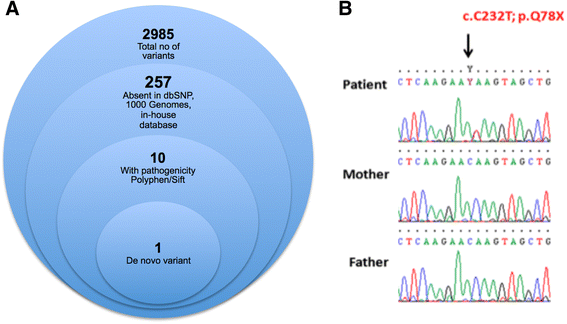A de novo CTNNB1 nonsense mutation associated with syndromic atypical hyperekplexia, microcephaly and intellectual disability: a case report
- PMID: 26968164
- PMCID: PMC4788907
- DOI: 10.1186/s12883-016-0554-y
A de novo CTNNB1 nonsense mutation associated with syndromic atypical hyperekplexia, microcephaly and intellectual disability: a case report
Abstract
Background: In addition to its role in cell adhesion and gene expression in the canonical Wingless/integrated Wnt signaling pathway, β-catenin also regulates genes that underlie the transmission of nerve impulses. Mutations of CTNNB1 (β-catenin) have recently been described in patients with a wide range of neurodevelopmental disorders (intellectual disability, microcephaly and other syndromic features). We for the first time associate CTNNB1 mutation with hyperekplexia identifying it as an additional candidate for consideration in patients with startle syndrome.
Case presentation: We describe an 11 year old male Polish patient with a de novo nonsense mutation in CTNNB1 who in addition to the major features of CTNNB1-related syndrome including intellectual disability and microcephaly, exhibited hyperekplexia and apraxia of upward gaze. The patient became symptomatic at the age of 20 months exhibiting delayed speech and psychomotor development. Social and emotional development was normal but mild hyperactivity was noted. Episodic falls when startled by noise or touch were observed from the age of 8.5 years, progressively increasing but never with loss of consciousness. Targeted gene panel next generation sequencing (NGS) and patient-parents trio analysis revealed a heterozygous de novo nonsense mutation in exon 3 of CTNNB1 identifying a novel association of β-catenin with hyperekplexia.
Conclusion: We report for the first time a clear association of mutation in CTNNB1 with an atypical syndromic heperekplexia expanding the phenotype of CTNNB1-related syndrome. Consequently CTNNB1 should be added to the growing list of genes to be considered as a cause of startle disease or syndromic hyperekplexia.
Keywords: Hyperekplexia; Intellectual disability; Microcephaly; β-catenin.
Figures
Similar articles
-
Identification of a novel de novo mutation in the CTNNB1 gene in an Iranian patient with intellectual disability.Neurol Sci. 2022 Apr;43(4):2859-2863. doi: 10.1007/s10072-022-05904-4. Epub 2022 Jan 31. Neurol Sci. 2022. PMID: 35099645
-
De novo mutations in beta-catenin (CTNNB1) appear to be a frequent cause of intellectual disability: expanding the mutational and clinical spectrum.Hum Genet. 2015 Jan;134(1):97-109. doi: 10.1007/s00439-014-1498-1. Epub 2014 Oct 19. Hum Genet. 2015. PMID: 25326669
-
Exome sequencing identifies a de novo mutation of CTNNB1 gene in a patient mainly presented with retinal detachment, lens and vitreous opacities, microcephaly, and developmental delay: Case report and literature review.Medicine (Baltimore). 2017 May;96(20):e6914. doi: 10.1097/MD.0000000000006914. Medicine (Baltimore). 2017. PMID: 28514307 Free PMC article. Review.
-
A new intellectual disability syndrome caused by CTNNB1 haploinsufficiency.Am J Med Genet A. 2014 Jun;164A(6):1571-5. doi: 10.1002/ajmg.a.36484. Epub 2014 Mar 25. Am J Med Genet A. 2014. PMID: 24668549
-
Case report of novel DYRK1A mutations in 2 individuals with syndromic intellectual disability and a review of the literature.BMC Med Genet. 2016 Feb 27;17:15. doi: 10.1186/s12881-016-0276-4. BMC Med Genet. 2016. PMID: 26922654 Free PMC article. Review.
Cited by
-
Targeted sequencing identifies 91 neurodevelopmental-disorder risk genes with autism and developmental-disability biases.Nat Genet. 2017 Apr;49(4):515-526. doi: 10.1038/ng.3792. Epub 2017 Feb 13. Nat Genet. 2017. PMID: 28191889 Free PMC article.
-
Dissecting Molecular Genetic Mechanisms of 1q21.1 CNV in Neuropsychiatric Disorders.Int J Mol Sci. 2021 May 28;22(11):5811. doi: 10.3390/ijms22115811. Int J Mol Sci. 2021. PMID: 34071723 Free PMC article. Review.
-
Clinical features associated with CTNNB1 de novo loss of function mutations in ten individuals.Eur J Med Genet. 2017 Feb;60(2):130-135. doi: 10.1016/j.ejmg.2016.11.008. Epub 2016 Nov 30. Eur J Med Genet. 2017. PMID: 27915094 Free PMC article.
-
A de novo CTNNB1 Novel Splice Variant in an Adult Female with Severe Intellectual Disability.Int Med Case Rep J. 2020 Oct 7;13:487-492. doi: 10.2147/IMCRJ.S270487. eCollection 2020. Int Med Case Rep J. 2020. PMID: 33116939 Free PMC article.
-
Advances in hyperekplexia and other startle syndromes.Neurol Sci. 2021 Oct;42(10):4095-4107. doi: 10.1007/s10072-021-05493-8. Epub 2021 Aug 11. Neurol Sci. 2021. PMID: 34379238 Review.
References
-
- Kuechler A, Willemsen MH, Albrecht B, Bacino CA, Bartholomew DW, van Bokhoven H, et al. De novo mutations in beta-catenin (CTNNB1) appear to be a frequent cause of intellectual disability: expanding the mutational and clinical spectrum. Hum Genet. 2015;134(1):97–109. doi: 10.1007/s00439-014-1498-1. - DOI - PubMed
Publication types
MeSH terms
Substances
LinkOut - more resources
Full Text Sources
Other Literature Sources
Miscellaneous


